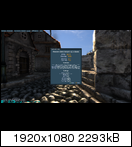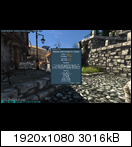I'll take triple buffering over adaptive vsync any day, as it's not like such cards will be lacking enough VRAM to use a second back buffer.Although given the choice between the two, especially on a card of this power I'd take 60fps any day.
Install the app
How to install the app on iOS
Follow along with the video below to see how to install our site as a web app on your home screen.
Note: This feature may not be available in some browsers.
You are using an out of date browser. It may not display this or other websites correctly.
You should upgrade or use an alternative browser.
You should upgrade or use an alternative browser.
How so?vsync off with a 120Hz display is nice too.
UniversalTruth
Veteran
I've gotta say I'm pretty damn excited about Kepler after the recent leaks. Outperforming the 7970 with all the benefits of adaptive vsycn TXAA and PhysX support. And all that at lower power draw/heat and presumably lower noise. I won't be going for the top end (rip off) edition but a 670Ti should be a massive upgrade over my 4890.
Yeah, something in line with around or even more than 100% performance improvement over your HD4890. At presumably lower price than the 7970 too.
According to a fellow GTX 570 user, these are his results of 2.5 vs 3.0 with the 570 at stock.


There is indeed gains with the newer version (including AMD hardware). Thanks
As we are in Unigine 3.0, and SLI test will drop enough soon, here's 2x 7970 as reference for score ( full quality, 1080P ) ... 2.5 > 3.0 = +10-15fps difference single cards ..
last driver 12.2, Cat AI in HQ, stock GPU's. all score with 16xAF .
Normal tesselation:

Extreme tesselation:

Extreme + 4xMSAA:

Extreme + 8xMSAA:

Extreme + 8xMSAA, little OC ( 1050/1500 ):

last driver 12.2, Cat AI in HQ, stock GPU's. all score with 16xAF .
Normal tesselation:

Extreme tesselation:

Extreme + 4xMSAA:

Extreme + 8xMSAA:

Extreme + 8xMSAA, little OC ( 1050/1500 ):

Last edited by a moderator:
Yeah, 10-15 FPS increase seems about right for 3.0. If this is the result of better optimizations/development using DX11 then things are looking good for DX11 gaming as a whole. Does anyone know when benchmarks hit the net? I read somewhere near the 22nd.As we are in Unigine 3.0, and SLI test will drop enough soon, here's 2x 7970 as reference for score ( full quality, 1080P ) ... 2.5 > 3.0 = +10-15fps difference single cards ...
UniversalTruth
Veteran
Does anyone know when benchmarks hit the net? I read somewhere near the 22nd.
6:00 am PT (USA), 2:00 pm UTC (UK), March 22nd.
Blazkowicz
Legend
How so?
haven't looked much at a 120Hz LCD so my experience is based on 120Hz CRT or lower.
it's way faster so you don't really see the tearing lines, and tearing itself happens less often I believe.
so if you have a very high refresh rate I find vsync-off double buffering to be the no-brainer setting.
vsync does bring an impression of perfect movement though, if your framerate is so high it's permanently locked all the way up (such as playing an old game of counterstrike or quake 3)
vsync at full framerate with tearing below would still be a nice addition in this case. (or good old triple buffering an option, I used that in strategy games where tearing is very ugly)
Last edited by a moderator:
I think the rage needs to stop. It's neither on topic, nor particularly warranted by anything that has happened in this thread. Moreover, what if the post that caused it is a nugget hidden in plain sight? And even if it's not, this sort of behaviour is not proper in any particular metric. Now, let's get back to the coming of Kepler, shall we?
It's not going to change the opinion of the gullible, but 3 years after the fact, it's probably time to settle this once and for all: the issue in GF100-A01 was in a back-end bus that fed the memory controllers. It was not even in the general xbar that interconnects the usual agents. There was a custom designed cell that with a timing violation that was not picked up during characterization.
The net result was a broken MC system (no transactions to external memory at all), but not a bricked chip: major parts could be verified by rendering to PC memory over PCIe. A02 fixed all known bugs, but not those that were hiding behind MC specific paths, so A03 was needed.
GF100-A01 had no issues at all with distributing geometry across GPCs. Distributed geometry never comes up in discussions about power. I don't think it should surprise anyone with a bit of a brain that SMs+TEX are where the power is.
Also: don't fret so much about crossbars in general. It's under control.
(Crawling back into my bear cave...)
This is a fascinating story and I'd like to read more about it, but I'm guessing that's not likely to happen.
As is, it's probably not going to dispell many commonly regurgitated myths.
Hmm, perhaps all that is needed is a website, though? I'm thinking that if you just constantly self-reference wild claims, eventually it will become reiterated truthiness. If only I knew any journalists that would work like this.
As for Kepler, it's looking like a winner to me, but the Turbo Boost thing seems a little odd. Is this just maximising TDP when not all functional units are in use, like in CPUs? There's no race to idle in GPUs is there, any spare cycles would just generate more frames?
Last edited by a moderator:
GTX 680 overclocked:
http://itbbs.pconline.com.cn/diy/15052972.html
1110MHz core
7.2Gbps memory
~8% higher GPU score over HKEPC
http://itbbs.pconline.com.cn/diy/15052972.html
1110MHz core
7.2Gbps memory
~8% higher GPU score over HKEPC
If nv inspector shows vid right it's impressive for 987mV.. Long way to play around 1175mV and there is still a option to remove voltage cap 1212mV
Last edited by a moderator:
GTX 680 overclocked:
http://itbbs.pconline.com.cn/diy/15052972.html
1110MHz core
7.2Gbps memory
~8% higher GPU score over HKEPC
I wonder if that really counts as overclocking
If nv inspector shows vid right it's impressive for 987mV.. Long way to play around 1175mV and there is still a option to remove voltage cap 1212mV
987 appears to be 2d, ~1070mv for 3d @ 1006mhz. Check that hkepc review and look at the EVGA precision screenshot, you can see 987mv @ 326mhz, and slightly higher when 1006mhz. Regardless, it still looks very promising. Precision maxing its gui at 2000mv and 1500mhz
You may be right but i find it pretty high for 2d clocks, it was 912mV for 400/800MHz for fermi, of course it's different arch and different process node but im sceptical.. also EVGA tool and nvisnpector conflicts, nvinspecter says card is on P0 state which is 3D state @987mV but evga says otherwise 326MHz@987mV.. it may be stucked at same vid while decreasing the clocks, it would also explain why it draws higher power than 7970 between test sequences.. apparently it's not clear to conclude a result for either way lol987 appears to be 2d, ~1070mv for 3d @ 1006mhz. Check that hkepc review and look at the EVGA precision screenshot, you can see 987mv @ 326mhz, and slightly higher when 1006mhz. Regardless, it still looks very promising. Precision maxing its gui at 2000mv and 1500mhz
http://chinese.vr-zone.com/12537/nvidia-gtx680-sli-in-3dmark11-03182012/
What happened to 1.4Ghz on air? All I see are measly overclocks that barely go beyond turbo.
What happened to 1.4Ghz on air? All I see are measly overclocks that barely go beyond turbo.
Similar threads
- Replies
- 12
- Views
- 2K
- Replies
- 183
- Views
- 18K
- Replies
- 85
- Views
- 11K



